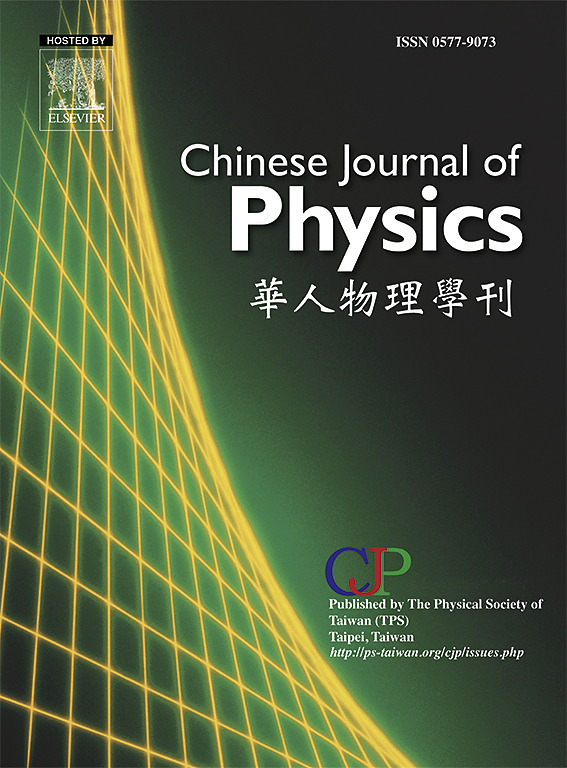无重力条件下具有Cattaneo-Christov热流的Maxwell粘弹性液体的Marangoni不稳定性
IF 4.6
2区 物理与天体物理
Q1 PHYSICS, MULTIDISCIPLINARY
引用次数: 0
摘要
在假定液体热流符合Cattaneo-Christov本构方程的前提下,分析了具有有限导热系数的厚壁粘弹性液膜的Marangoni不稳定性。这个分析是在没有重力的情况下进行的,因为浮力对于薄的液体薄膜可以忽略不计。研究了普朗特数(Pr)、粘弹性弛豫时间(F)、热弛豫时间(t)以及壁面的热学性质和几何性质对热毛细对流发生的影响。Pr的影响在5到100的范围内进行了测试,这是聚合物悬浮液的特征。壁面的导热系数通过流体与壁面的导热系数比值(从10−7到107不等)来量化,从而涵盖了理想导热体和绝热壁面的极限情况,以及中间情况。通过将壁厚与流体深度的比值设置为薄壁为0.1,厚壁为100,分析了壁厚的影响。方法:通过扰动和线性化运动和能量控制方程来进行线性稳定性分析。对速度和温度扰动进行正态展开,得到稳定性参数马兰戈尼数解析可解的特征值问题。然后对该数值进行数值计算,以确定在不同参数集下的边缘和临界状态。主要发现:对于较大的t或F值,振荡对流优于平稳模式。增加的t增加了不稳定性,而Pr的影响则随f的变化而变化,要么使系统稳定,要么使系统不稳定。在特定的参数范围内,会出现以不同的波数和频率为特征的相互竞争的振荡模式。此外,壁的性质——如导热系数、比热和厚度——会显著影响单调和振荡不稳定性的发生条件。本文章由计算机程序翻译,如有差异,请以英文原文为准。

Marangoni instability of a Maxwell’s viscoelastic liquid with Cattaneo–Christov heat flux in the absence of gravity
The Marangoni instability of a viscoelastic liquid film coating a thick wall with finite thermal conductivity is analyzed under the assumption that the liquid heat flux follows the Cattaneo–Christov constitutive equation. This analysis is conducted in the absence of gravity, as buoyancy forces can be neglected for thin liquid films. This study investigates the influence of the Prandtl number (), the viscoelastic relaxation time (), the thermal relaxation time (), and the wall’s thermal and geometric properties on the onset of thermocapillary convection. The effect of is examined within the range of 5 to 100, which is characteristic of polymeric suspensions. The wall’s thermal conductivity is quantified using the fluid-to-wall conductivity ratio, varying from 10−7 to 10, thus encompassing the limiting cases of an ideal heat conductor and an adiabatic wall, along with intermediate scenarios. The effect of wall thickness is analyzed by setting the ratio of wall thickness to fluid depth to 0.1 for a thin wall and 100 for a thick wall.
Methodology:
A linear stability analysis is performed by perturbing and linearizing the governing equations of motion and energy. A normal mode expansion is applied to velocity and temperature perturbations, leading to an eigenvalue problem that is analytically solvable for the stability parameter, the Marangoni number. This number is then computed numerically to determine the marginal and critical states under varying parameter sets.
Key findings:
For large values of or , oscillatory convection dominates over stationary modes. Increasing enhances instability, while the effect of varies, either stabilizing or destabilizing the system depending on . Competing oscillatory modes, characterized by distinct wavenumbers and frequencies, arise within specific parameter regimes. Additionally, wall properties — such as thermal conductivity, specific heat, and thickness — significantly influence the onset conditions for both monotonic and oscillatory instabilities.
求助全文
通过发布文献求助,成功后即可免费获取论文全文。
去求助
来源期刊

Chinese Journal of Physics
物理-物理:综合
CiteScore
8.50
自引率
10.00%
发文量
361
审稿时长
44 days
期刊介绍:
The Chinese Journal of Physics publishes important advances in various branches in physics, including statistical and biophysical physics, condensed matter physics, atomic/molecular physics, optics, particle physics and nuclear physics.
The editors welcome manuscripts on:
-General Physics: Statistical and Quantum Mechanics, etc.-
Gravitation and Astrophysics-
Elementary Particles and Fields-
Nuclear Physics-
Atomic, Molecular, and Optical Physics-
Quantum Information and Quantum Computation-
Fluid Dynamics, Nonlinear Dynamics, Chaos, and Complex Networks-
Plasma and Beam Physics-
Condensed Matter: Structure, etc.-
Condensed Matter: Electronic Properties, etc.-
Polymer, Soft Matter, Biological, and Interdisciplinary Physics.
CJP publishes regular research papers, feature articles and review papers.
 求助内容:
求助内容: 应助结果提醒方式:
应助结果提醒方式:


